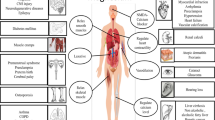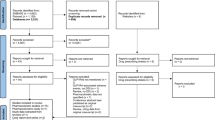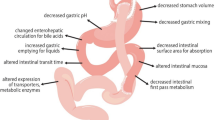Summary
The following summarises the contents of both this review and its predecessor in this journal (Iisalo, 1977). The two reviews should be read in conjunction with each other.
Digoxin is absorbed mostly from the proximal part of the small intestine. About 67% is absorbed from tablets, 80% from elixir and up to 100% from encapsulated elixir. Protein binding of digoxin and its metabolites is low and of little clinical significance. Digoxin is widely distributed throughout body tissues and has a high apparent volume of distribution (about 6L/kg). Although most of the digoxin in the body is in skeletal muscle it is found in highest concentrations in the heart, kidneys and brain. The apparent volume of distribution is reduced in patients with renal impairment and in the elderly. Plasma digoxin concentrations do not closely reflect myocardial whole tissue concentrations.
The half-time of elimination in healthy subjects averages 40 hours. In most patients, more than 80% of digoxin is excreted unchanged in the urine but in about 12% of patients between 20% and 55% is excreted as metabolites, mostly dihydrodigoxin, which is relatively inactive. In a few subjects other, more active, metabolites may be found in the urine. Renal elimination is mainly by glomerular filtration but some passive tubular reabsorption and active secretion occur.
The relationships between plasma digoxin concentrations and its pharmacodynamic or therapeutic effects are not clear. However, plasma digoxin concentrations may relate well to the slowing of ventricular rate from pre-treatment values in atrial fibrillation but not to resting ventricular rates. In cardiac failure in sinus rhythm, plasma digoxin concentrations may relate well to the inotropic effect of the drug but theoretical tissue digoxin concentrations may be more closely related.
Digoxin passes across the placenta and into breast milk but not in sufficient quantities to prove harmful to the fetus or neonate.
In renal impairment, the half-time of digoxin is prolonged and its apparent volume of distribution reduced.
The pharmacokinetics of digoxin in different states of thyroid function are complex and do not fully explain, for example, the apparent ‘resistance’ to digoxin in hyperthyroidism.
The most important digoxin-drug interactions are those involving quinidine and drugs which deplete the body of potassium.
Plasma (or serum) digoxin concentration measurement may be of value in the diagnosis of toxicity or undertreatment, in overdose and in changing treatment in patients with renal impairment or on long term therapy.
Similar content being viewed by others
References
Allonen, H.; Andersson, K.-E.; Iisalo, L.E.; Kanto, J.; Strömblad, L.-G. and Wettrell, G.: Passage of digoxin into cerebrospinal fluid in man. Acta Pharmacologics et Toxicologica 41: 193–202 (1977).
Allonen, H.; Kanto, J. and Iisalo, E.: The foeto-maternal distribution of digoxin in early human pregnancy. Acta Pharmacologica et Toxicologica 39: 477–480 (1976).
Andersen, K.E. and Damsgaard, T.: The effect on serum enzymes of intramuscular injections of digoxin, bumetanide, pentazocine and isotonic sodium chloride. Acta Medica Scandinavica 199: 317–319 (1976).
Andersson, K.-E.; Bertler, A. and Wettrell, G.: Post-mortem distribution and tissue concentrations of digoxin in infants and adults. Acta Paediatrica Scandinavica 64: 497–504 (1975).
Aronson, J.K.: Studies on the clinical pharmacology of cardiac glycosides. D. Phil. Thesis, Oxford (1977).
Aronson, J.K.: Cardiac glycosides and drugs used in dysrhythmias; in Dukes (Ed.) Side Effects of Drugs Annual II Chapter 17a (Excerpta Medica, Amsterdam 1978a).
Aronson, J.K.: Monitoring digoxin therapy: III How useful are the nomograms? British Journal of Clinical Pharmacology 5: 55–64 (1978b).
Aronson, J.K.: Cardiac glycosides and drugs used in dysrhythmias; in Dukes (Ed) Side Effects of Drugs Annuals IV, Chapter 17a (Excerpta Medica, Amsterdam 1980).
Aronson, J.K. and Grahame-Smith, D.G.: Altered distribution of digoxin in renal failure — a cause of digoxin toxicity?. British Journal of Clinical Pharmacology 3: 1045–1051 (1976).
Aronson, J.K. and Grahame-Smith, D.G.: Monitoring digoxin therapy: II. Determinants of the apparent volume of distribution. British Journal of Clinical Pharmacology 4: 223–227 (1977).
Aronson, J.K.; Grahame-Smith, D.G.; Hallis, K.F.; Hibble, A. and Wigley, F.M.: Monitoring digoxin therapy: I. Plasma concentrations and an in vitro assay of tissue response. British Journal of Clinical Pharmacology 4: 213–221 (1977).
Aronson, J.K.; Grahame-Smith, D.G. and Wigley, F.M.: Monitoring digoxin therapy: The use of plasma digoxin concentration measurements in the diagnosis of digoxin toxicity. Quarterly Journal of Medicine NS47: 111–112 (1978).
Bertler, A.; Andersson, K.-E. and Wettrell, G.: Concentration of digoxin in choroid plexus. Lancet 2: 1453–1454 (1973).
Biddle, T.L.; Weintraub, M. and Lasagna, L.: Relationship of serum and myocardial digoxin concentration to electrocardiographic estimation of digoxin intoxication. Journal of Clinical Pharmacology 18: 10–15 (1978).
Binnion, P.F.; Morgan, L.M.; Stevenson, H.M. and Fletcher, E.: Plasma and myocardial digoxin concentrations in patients on oral therapy. British Heart Journal 31: 636–640 (1969).
Bonelli, J.; Haydl, H.; Hruby, K. and Kaik, G.: The pharmacokinetics of digoxin in patients with manifest hyperthyroidism and after normalization of thyroid function. International Journal of Clinical Pharmacology 16: 302–306 (1978).
Brock, A.: Binding of digitoxin and digoxin to normal human β-lipoproteins. Acta Pharmacologica et Toxicologica 38: 267–272 (1976).
Buchanan, N.; van der Walt, L.A. and Striekwold, B.: Pharmacology of nutrition. III: Binding of digoxin to normal and kwashiorkor serum. Journal of Pharmaceutical Sciences 65: 914–916 (1976).
Carliner, N.H.; Gilbert, Ch.A.; Pruitt, A.W. and Goldberg, L.I.: Effects of maintenance digoxin therapy on systolic time intervals and serum digoxin concentrations. Circulation 50: 94–98 (1974).
Carroll, P.R.; Gelbart, A.; O’Rourke, M.F. and Shortus, J.: Digoxin concentrations in the serum and myocardium of digitalised patients. Australian and New Zealand Journal of Medicine 3: 400–403 (1973).
Carruthers, S.G.; Cleland, J.; Kelly, J.G.; Lyons, S.M. and McDevitt, D.G.: Plasma and tissue digoxin concentrations in patients undergoing cardiopulmonary bypass. British Heart Journal 37: 313–320 (1975).
Chamberlain, D.A.; White, R.J.; Howard, M.R. and Smith, T.W.: Plasma digoxin concentrations in patients with atrial fibrillation. British Medical Journal 3: 429–432 (1970).
Chan, V.; Tse, T.F. and Wong, V.: Transfer of digoxin across the placenta and into breast milk. British Journal of Obstetrics and Gynaecology 85: 605–609 (1978).
Clark, D.R. and Kaiman, S.M.: Dihydrodigoxin: A common metabolite of digoxin in man. Drug Metabolism and Disposition 2: 148–150 (1974).
Cole, C.H. and Waddell, R.W.: Alteration in intracellular sodium concentration and ouabain-sensitive ATPase in erythrocytes from hyperthyyroid patients. Journal of Clinical Endocrinology and Metabolism 42: 1056–1063 (1970).
Coltart, D.J.; Güllner, H.G.; Billingham, M.; Goldman, R.H.; Stinson, E.B.; Kaiman, S.M. and Harrison, D.C.: Physiological distribution of digoxin in human heart. British Medical Journal 4: 733–736 (1974).
Coltart, D.J.; Howard, M. and Chamberlain, D.: Myocardial and skeletal muscle concentrations of digoxin in patients on long-term therapy. British Medical Journal 2: 318–319 (1972).
Croxson, M.S. and Ibbertson, H.K.: Serum digoxin in patients with thyroid disease. British Medical Journal iii: 566–568 (1975).
Cusack, B.; Kelly, J.; O’Malley, K.; Noel, J.; Lavan, J. and Horgan, J.: Digoxin in the elderly: Pharmacokinetic consequences of old age. Clinical Pharmacology and Therapeutics 25: 772–776 (1979).
Dobbs, S.M.; Parkes, J. and Rodgers, E.M.: Digoxin: linearity between dose and serum concentration. British Journal of Clinical Pharmacology 3: 940–941 (1976).
Doering, W.: Quinidine-digoxin interaction. New England Journal of Medicine 301: 400–409 (1979).
Doherty, J.E. and Perkins, W.H.: Digoxin metabolism in hypo-and hyperthyroidism. Studies with Vitiated digoxin in thyroid disease. Annals of Internal Medicine 64: 489–507 (1966).
Doherty, J.E.; Perkins, W.H. and Flanigan, W.J.: The distribution and concentration of tritiated digoxin in human tissues. Annals of Internal Medicine 66: 116–124 (1967).
Ekins, B.R. and Watanabe, A.S.: Acute digoxin poisonings: review of therapy. American Journal of Hospital Pharmacy 35: 268–277 (1978).
Ford, A.R.; Aronson, J.K.; Grahame-Smith, D.G. and Carver, J.G.: Changes in cardiac glycoside receptor sites, 86rubidium uptake and intracellular sodium concentrations in the erythrocytes of patients receiving digoxin during the early phases of treatment of cardiac failure in regular rhythm and of atrial fibrillation. British Journal of Clinical Pharmacology 8: 125–134 (1979).
Gayes, J.M.; Greenblatt, D.J.; Lloyd, B.L.; Harmatz, J.S. and Smith, T.W.: Cerebrospinal fluid digoxin concentrations in humans. Journal of Clinical Pharmacology 18: 16–20 (1978).
Ghirardi, P.; Catenazzo, G.; Mantero, O.; Merotti, G.C. and Margo, A.: Bioavailability of digoxin in a new soluble pharmaceutical formulation in capsules. Journal of Pharmaceutical Sciences 66: 267–269 (1977).
Gilfrich, H.J.: Untersuchungen zur Pharmakokinetik von Digoxin bei hyperthyreoten Patienten. Verhandlunger der Deutscher Gesellschaft fur Innere Medizin 82: 1726–1728 (1976).
Goldman, S.; Probst, P.; Selzer, A. and Cohn, K.: Inefficacy of “therapeutic” serum levels of digoxin in controlling the ventricular rate in atrial fibrillation. American Journal of Cardiology 35: 651–655 (1975).
Güllner, H.G.; Stinson, E.B.; Harrison, D.C. and Kaiman, S.M.: Correlation of serum concentrations with heart concentrations of digoxin in human subjects. Circulation 50: 653–655 (1974).
Hager, W.D.; Fenster, P.; Mayersohn, M.; Perrier, D.; Graves, P.; Marcus, F.I. and Goldman, S.: Digoxin — quinidine interaction. New England Journal of Medicine 300: 1238–1241 (1979).
Halkin, H.; Sheiner, L.B.; Peck, C.C. and Melmon, K.L.: Determinants of the renal clearance of digoxin. Clinical Pharmacology and Therapeutics 17: 385–394 (1975).
Hall, W.H. and Doherty, J.E.: Tritiated digoxin XVI. Gastric absorption. American Journal of Digestive Diseases 16: 903–908 (1971).
Hall, W.H. and Doherty, J.E.: Tritiated digoxin XXII. Absorption and excretion in malabsorption syndromes. American Journal of Medicine 56: 437–442 (1974).
Härtel, G.; Kyllonen, K.; Merikallio, E.; Ojala, K.; Manninen, V. and Reisseil, P.: Human serum and myocardium digoxin. Clinical Pharmacology and Therapeutics 19: 153–157 (1976).
Heiger, W.U.; Smith, T.W. and Goldfinger, S.E.: Absorption of digoxin in patients with malabsorption syndromes. New England Journal of Medicine 285: 257–259 (1971).
Hinderung, P.H.: Comparative studies of the protein binding of digoxin and its metabolites. Agents and Actions 7: 379–382 (1977).
Hoeschen, R.J. and Cuddy, T.E.: Dose-response relation between therapeutic levels of serum digoxin and systolic time intervals. American Journal of Cardiology 35: 469–472 (1975).
Hooymans, P.M. and Merkus, F.W.H.M.: Effect of quinidine on plasma concentration of digoxin. British Medical Journal 2: 1022 (1978).
Huffman, D.H.; Klaasen, C.D. and Hartman, C.R.: Digoxin in hyperthyroidism. Clinical Pharmacology and Therapeutics 22: 533–538 (1977).
Iisalo, E.: Clinical pharmacokinetics of digoxin. Clinical Pharmacokinetics 2: 1–16 (1977).
Iisalo, E. and Nuutila, M.: Myocardial digoxin concentrations in fatal intoxications. Lancet 1: 257 (1973).
Ingelfinger, J.A. and Goldman, P.: The serum digitalis concentration — does it diagnose digitalis toxicity?. New England Journal of Medicine 294: 867–899 (1976).
Ismail-Beigi, F. and Edelman, I.S.: The mechanism of the calorigenic action of thyroid hormone. Journal of General Physiology 57: 710–722 (1971).
Johnson, B.F.; Bye, C.; Jones, G. and Sabey, G.A.: A completely absorbed oral preparation of digoxin. Clinical Pharmacology and Therapeutics 19: 746–751 (1976).
Johnston, C.D. and McDevitt, D.G.: Digoxin dosage regimens —A comparison of intuitive and predicted digoxin prescribing. British Journal of Clinical Pharmacology 7: 435P–436P (1979).
Jusko, W.J.; Conti, D.R.; Molson, A.; Kuritzky, P.; Giller, J. and Schultz, R.: Digoxin absorption from tablets and elixir. The effect of radiation-induced malabsorption. Journal of the American Medical Association 230: 1554–1555 (1974).
Jusko, W.J. and Weintraub, M.: Myocardial distribution of digoxin and renal function. Clinical Pharmacology and Therapeutics 16: 449–454 (1974).
Karjalainen, J.; Ojala, K. and Reissell, P.: Tissue concentrations of digoxin in an autopsy material. Acta Pharmacologica et Toxicologica 34: 385–390 (1974).
Kim, Y.I.; Noble, R.J. and Zipes, D.P.: Dissociation of the inotropic effect of digitalis from its effect on atrioventricular conduction. American Journal of Cardiology 36: 459–467 (1975).
Krakauer, R. and Steinness, E.: Digoxin concentration in choroid plexus, brain and myocardium in old age. Clinical Pharmacology and Therapeutics 24: 454–458 (1978).
Kramer, P.; Kothe, E.; Saul, J. and Scheler, F.: Uraemic and normal plasma protein binding of various cardiac glycosides under ‘in vivo’ conditions. European Journal of Clinical Investigation 4: 53–58 (1974).
Lawrence, J.R.; Sumner, D.J.; Kalk, W.J.; Ratcliffe, W.A.; Whiting, B.; Gray, K. and Lindsay, M.: Digoxin kinetics in patients with thyroid dysfunction. Clinical Pharmacology and Therapeutics 22: 7–13 (1977).
Levitt, B.; Cagin, N.; Kleid, J.; Somberg, J. and Gillis, R.: Role of the nervous system in the genesis of cardiac rhythm disorders. American Journal of Cardiology 37: 1111–1113 (1976).
Levy, M.; Granit, L. and Laufer, N.: Excretion of drugs in human milk. New England Journal of Medicine 297: 789 (1977).
Lichey, J.; Havestatt, Ch.; Weinmann, J.; Hasford, J. and Rietbrock, N.: Human myocardium and plasma digoxin concentration in patients on long-term digoxin therapy. International Journal of Clinical Pharmacology 16: 460–462 (1978).
Loo, J.C.K.; McGilveray, I.J. and Jordan, N.: Quantitation of digoxigenin in serum following oral administration of digoxin in humans. Research Communications in Chemical Pathology and Pharmacology 16: 497–506 (1977).
Loughnan, P.M.: Digoxin excretion in human breast milk. Journal of Pediatrics 92: 1019–1020 (1978).
Luchi, R.J. and Gruber, J.W.: Unusually large digitalis requirements — study of altered digoxin metabolism. American Journal of Medicine 45: 322–328 (1968).
Mallis, G.I.; Schmidt, D.H. and Lindenbaum, J.: Superior bioavailability of digoxin solution in capsules. Clinical Pharmacology and Therapeutics 18: 761–768 (1975).
Morrow, D.H.; Gaffney, T.E. and Braumwald, E.: Studies on digitalis. VII. Influence of hyper- and hypothyroidism on the myocardial response to ouabain. Journal of Pharmacology and Experimental Therapeutics 140: 324–328 (1963).
Ochs, H.R.; Greenblatt, D.J.; Bodem, G. and Harmatz, J.S.: Dose-independent pharmacokinetics of digoxin in humans. American Heart Journal 96: 507–511 (1978).
Okada, R.D.; Hager, W.; Graves, P.E.; Mayersohn, M.; Perrier, D.G. and Marcus, F.I.: Relationship between plasma concentration and dose of digoxin in patients with and without renal impairment. Circulation 58: 1196–1203 (1978).
Peck, C.; Steiner, L.; Martin, M.; Coombs, T. and Melnion, K.L.: Computer-assisted digoxin therapy. New England Journal of Medicine 289: 441–446 (1973).
Penchas, S. and Zajicek, G.: Plasma digoxin levels and the interbeat interval signal in atrial fibrillation. Zeitung fur Kardiologie 67: 104–108 (1978).
Peters, U.; Falk, L.C. and Kaiman, S.M.: Digoxin metabolism in patients. Archives of Internal Medicine 138: 1074–1076 (1978).
Plassaras, G.; Stamatelopoulos, S.; Sideris, D.; Athanasiadis, P. and Moulopoulos, S.M.: Effect of digitalis on systolic time intervals in thyrotoxicosis. Endocrinologica experimentalis 8: 311–318 (1974).
Redfors, A.: Plasma digoxin concentration — its relation to digoxin dosage and clinical effects in patients with atrial fibrillation. British Heart Journal 34: 383–391 (1972).
Redfors, A.; Bertler, A. and Schüller, H.: The ratio between myocardial and plasma levels of digoxin in man; in Storstein, Nitter-Hange and Storstein (Eds) Symposium on Digitalis, p. 265–269 (Gyldendal Norsk Forlag, Oslo, 1973).
Reuning, R.H.; Sams, R.A. and Notari, R.E.: Role of pharmacokinetics in drug dosage adjustment. I. Pharmacologic effect kinetics and apparent volume of distribution of digoxin. Journal of Clinical Pharmacology 13: 127–141 (1973).
Rogers, M.C.; Willerson, I.T.; Goldblatt, A. and Smith, T.W.: Serum digoxin concentrations in the human fetus, neonate and infant. New England Journal of Medicine 287: 1010–1013 (1972).
Shapiro, W.; Narahara, K. and Taubert, K.: Relationship of plasma digitoxin and digoxin to cardiac response following intravenous digitalisation in man. Circulation 42: 1065–1072 (1970).
Shenfield, G.M.; Thompson, J. and Horn, D.B.: Plasma and urinary digoxin in thyroid dysfunction. European Journal of Clinical Pharmacology 12: 437–443 (1977).
Spurell, R.A.J.; Harris, A.M. and Howard, M.R.: Effect of digoxin on A-V conduction. British Medical Journal 3: 563–564 (1971).
Steiness, E.: Renal tubular secretion of digoxin. Circulation 50: 103–107 (1974).
Steiness, E.; Svendsen, O. and Rasmussen, F.: Plasma digoxin after parenteral administration. Local reaction after intramuscular injection. Clinical Pharmacology and Therapeutics 16: 430–434 (1974).
Szefler, J.J. and Jusko, W.J.: Decreased volume of distribution of digoxin in a patient with renal failure. Research Communications in Chemical Pathology and Pharmacology 6: 1095–1098 (1973).
Wagner, J.G.: Loading and maintenance doses of digoxin in patients with normal renal function and those with severely impaired renal function. Journal of Clinical Pharmacology 14: 329–338 (1974).
Wagner, J.G.; Yates, J.D.; Willis, P.W.; Sakmar, E. and Stoll, R.G.: Correlation of plasma levels of digoxin in patients with dose and measure of renal function. Clinical Pharmacology and Therapeutics 15: 291–301 (1974).
Waldorff, S.; Andersen, J.D.; Heeboll-Nielsen, N.; Nielsen, O.G.; Moltke, E.; Sorensen, U. and Steiness, E.: Spironolactone-induced changes in digoxin kinetics. Clinical Pharmacology and Therapeutics 24: 162–167 (1978).
Weintraub, M. and Lasagna, L.: Serum and tissue concentrations of digoxin. A clinical and pathologic analysis. Clinical Pharmacology and Therapeutics 14: 149 (1973).
Williams, P.; Aronson, J.K. and Sleight, P.: Is a slow pulse rate a reliable sign of digitalis toxicity?. Lancet 2: 1340–1342 (1978).
Author information
Authors and Affiliations
Rights and permissions
About this article
Cite this article
Aronson, J.K. Clinical Pharmacokinetics of Digoxin 1980. Clin Pharmacokinet 5, 137–149 (1980). https://doi.org/10.2165/00003088-198005020-00002
Published:
Issue Date:
DOI: https://doi.org/10.2165/00003088-198005020-00002




